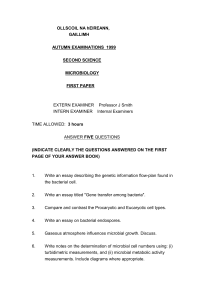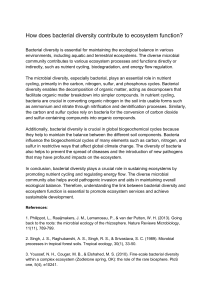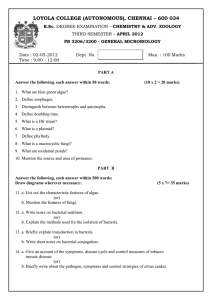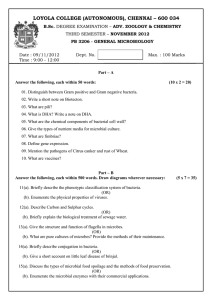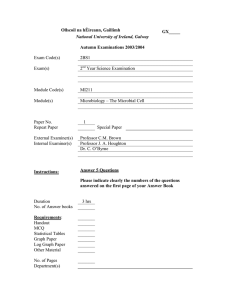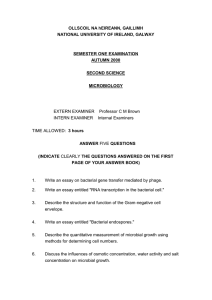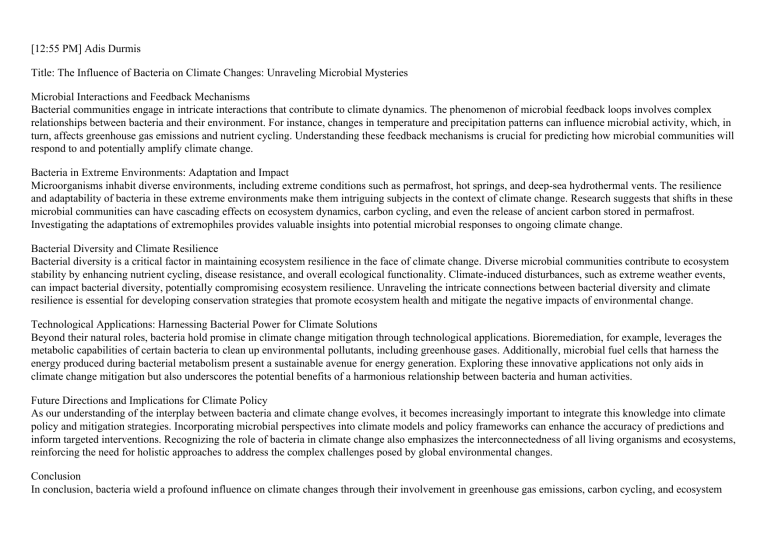
[12:55 PM] Adis Durmis Title: The Influence of Bacteria on Climate Changes: Unraveling Microbial Mysteries Microbial Interactions and Feedback Mechanisms Bacterial communities engage in intricate interactions that contribute to climate dynamics. The phenomenon of microbial feedback loops involves complex relationships between bacteria and their environment. For instance, changes in temperature and precipitation patterns can influence microbial activity, which, in turn, affects greenhouse gas emissions and nutrient cycling. Understanding these feedback mechanisms is crucial for predicting how microbial communities will respond to and potentially amplify climate change. Bacteria in Extreme Environments: Adaptation and Impact Microorganisms inhabit diverse environments, including extreme conditions such as permafrost, hot springs, and deep-sea hydrothermal vents. The resilience and adaptability of bacteria in these extreme environments make them intriguing subjects in the context of climate change. Research suggests that shifts in these microbial communities can have cascading effects on ecosystem dynamics, carbon cycling, and even the release of ancient carbon stored in permafrost. Investigating the adaptations of extremophiles provides valuable insights into potential microbial responses to ongoing climate change. Bacterial Diversity and Climate Resilience Bacterial diversity is a critical factor in maintaining ecosystem resilience in the face of climate change. Diverse microbial communities contribute to ecosystem stability by enhancing nutrient cycling, disease resistance, and overall ecological functionality. Climate-induced disturbances, such as extreme weather events, can impact bacterial diversity, potentially compromising ecosystem resilience. Unraveling the intricate connections between bacterial diversity and climate resilience is essential for developing conservation strategies that promote ecosystem health and mitigate the negative impacts of environmental change. Technological Applications: Harnessing Bacterial Power for Climate Solutions Beyond their natural roles, bacteria hold promise in climate change mitigation through technological applications. Bioremediation, for example, leverages the metabolic capabilities of certain bacteria to clean up environmental pollutants, including greenhouse gases. Additionally, microbial fuel cells that harness the energy produced during bacterial metabolism present a sustainable avenue for energy generation. Exploring these innovative applications not only aids in climate change mitigation but also underscores the potential benefits of a harmonious relationship between bacteria and human activities. Future Directions and Implications for Climate Policy As our understanding of the interplay between bacteria and climate change evolves, it becomes increasingly important to integrate this knowledge into climate policy and mitigation strategies. Incorporating microbial perspectives into climate models and policy frameworks can enhance the accuracy of predictions and inform targeted interventions. Recognizing the role of bacteria in climate change also emphasizes the interconnectedness of all living organisms and ecosystems, reinforcing the need for holistic approaches to address the complex challenges posed by global environmental changes. Conclusion In conclusion, bacteria wield a profound influence on climate changes through their involvement in greenhouse gas emissions, carbon cycling, and ecosystem dynamics. From microbial feedback loops to the resilience of extremophiles, the microbial world adds layers of complexity to our understanding of climate change. Harnessing bacterial capabilities for technological solutions and integrating microbial insights into climate policy are avenues that hold promise for addressing the challenges posed by a changing climate. As we continue to unveil the mysteries of microbial contributions to climate change, a more comprehensive and nuanced approach to environmental stewardship emerges, promoting a sustainable coexistence between microorganisms and the broader ecosystem.
